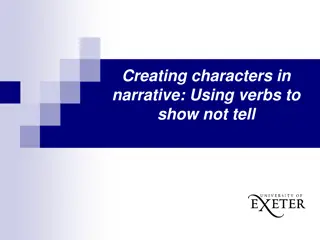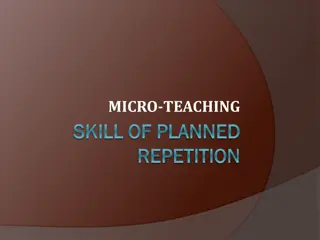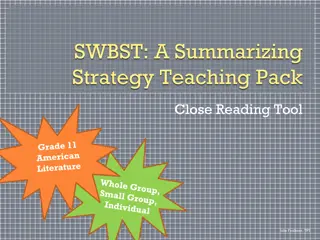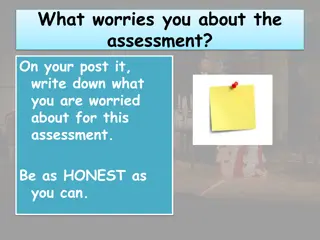Exploring Repetition in Texts to Understand Character Development
Delve into the deliberate use of repetition in text to unveil character traits and emphasize key moments in the plot. From establishing learning principles to noticing patterns in authentic texts like Dickens' work, discover how repeated elements serve to reveal character nuances and create impactful storytelling.
Download Presentation

Please find below an Image/Link to download the presentation.
The content on the website is provided AS IS for your information and personal use only. It may not be sold, licensed, or shared on other websites without obtaining consent from the author. Download presentation by click this link. If you encounter any issues during the download, it is possible that the publisher has removed the file from their server.
E N D
Presentation Transcript
Using deliberate repetition to reveal character and to highlight key moments in the plot
LEAD Principles PRINCIPLE LINKS EXPLANATION RATIONALE To establish a purposeful learning reason for addressing grammar, and connect grammar with meaning and rhetorical effect Make a link between the grammar being introduced and how it works in the writing being taught To avoid writing lessons becoming mini- grammar lessons, and to allow access to the structure even if the grammar concept is not fully understood To integrate reading and writing and show how real writers make language choices EXAMPLES Explain the grammar through examples, not lengthy explanations AUTHENTIC TEXTS Use authentic texts as models to link writers to the broader community of writers To promote deep metalinguistic learning about why a particular choice works, and to develop independence rather than compliance DISCUSSION Build in high-quality discussion about grammar and its effects
Noticing Patterns in a Text Authentic text Sitting-room, bedroom, lumber-room. All as they should be. Nobody under the table, nobody under the sofa; a small fire in the grate; spoon and basin ready; and the little saucepan of gruel (Scrooge had a cold in his head) upon the hob. Nobody under the bed; nobody in the closet; nobody in his dressing gown, which was hanging up in a suspicious attitude against the wall. Lumber room as usual. Old fire-guard, old shoes, two fish-baskets, washing-stand on three legs, and a poker. Discussion Quite satisfied, he closed his door, and locked himself in; double-locked himself in, which was not his custom. Thus secured against surprise, he took off his cravat; put on his dressing-gown and slippers, and his nightcap; and sat down before the fire to take his gruel. How many different kinds of repetition can you find in this extract? Is there too much?
Noticing Patterns in a Text Examples Sitting-room, bedroom, lumber-room. All as they should be. Nobody under the table, nobody under the sofa; a small fire in the grate; spoon and basin ready; and the little saucepan of gruel (Scrooge had a cold in his head) upon the hob. Nobody under the bed; nobody in the closet; nobody in his dressing gown, which was hanging up in a suspicious attitude against the wall. Lumber room as usual. Old fire-guard, old shoes, two fish- baskets, washing-stand on three legs, and a poker. Discussion Did you notice: the listing of rooms and everyday household objects in them how many clauses start in the same way: nobody under/in the number of minor sentences without a main verb What might these choices reveal about Scrooge s character and his state of mind? Links How is the repetition created? What effects does it have?
Noticing Patterns in a Text Examples Quite satisfied, he closed his door, and locked himself in; double-locked himself in, which was not his custom. Thus secured against surprise, he took off his cravat; put on his dressing-gown and slippers, and his nightcap; and sat down before the fire to take his gruel. Did you notice: the minor sentences without verbs have been replaced with lists of co-ordinated main clauses with finite verbs (closed, locked, double-locked, took off, put on, sat down) the verb choices that come from the same lexical field (closed, locked, double-locked, secured) What might these choices reveal about Scrooge s character and his state of mind? How do they prepare us for a key moment in the plot, the appearance of Marley s ghost? Discussion How is the repetition created? What effects does it have? Links
Verbalising the Grammar-Writing Link A crucial element of the LEAD principles is helping writers to think explicitly (metalinguistically) about the choices they make. As a teacher, you need to support this by being crystal clear yourself about how you verbalise the link between a grammar choice and its effect in a particular text/context. Then express this in student-friendly language, as below. Verbalisation to share with students: When you write fiction, you can think about how to show what a character is like or how to emphasise a key moment in the plot. You might want to draw attention to a character and to actions by using deliberate repetition in your vocabulary choices or sentence structures.
Authentic text Noticing Patterns in a Text Sitting-room, bedroom, lumber-room. All as they should be. Nobody under the table, nobody under the sofa; a small fire in the grate; spoon and basin ready; and the little saucepan of gruel (Scrooge had a cold in his head) upon the hob. Nobody under the bed; nobody in the closet; nobody in his dressing gown, which was hanging up in a suspicious attitude against the wall. Lumber room as usual. Old fire-guard, old shoes, two fish-baskets, washing-stand on three legs, and a poker. Discussion How effectively does Dickens use repetition of language and structure to reveal Scrooge s character and to highlight a key moment in the plot? Quite satisfied, he closed his door, and locked himself in; double-locked himself in, which was not his custom. Thus secured against surprise, he took off his cravat; put on his dressing-gown and slippers, and his nightcap; and sat down before the fire to take his gruel. Links























